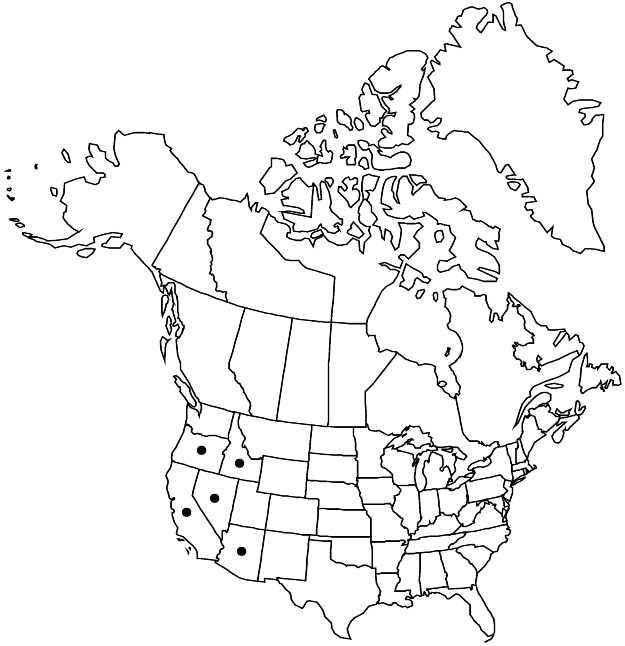Difference between revisions of "Chorizanthe brevicornu"
in W. H. Emory, Rep. U.S. Mex. Bound. 2(1): 177. 1859.
FNA>Volume Importer |
RevisionBot (talk | contribs) m (Bot: Adding category Revised Since Print) |
||
| (6 intermediate revisions by 3 users not shown) | |||
| Line 1: | Line 1: | ||
{{Treatment/ID | {{Treatment/ID | ||
|accepted_name=Chorizanthe brevicornu | |accepted_name=Chorizanthe brevicornu | ||
| − | |accepted_authority=Torrey | + | |accepted_authority=Torrey |
|publications={{Treatment/Publication | |publications={{Treatment/Publication | ||
|title=in W. H. Emory, Rep. U.S. Mex. Bound. | |title=in W. H. Emory, Rep. U.S. Mex. Bound. | ||
|place=2(1): 177. 1859 | |place=2(1): 177. 1859 | ||
|year=1859 | |year=1859 | ||
| + | }} | ||
| + | |special_status={{Treatment/ID/Special_status | ||
| + | |code=F | ||
| + | |label=Illustrated | ||
}} | }} | ||
|basionyms= | |basionyms= | ||
| Line 19: | Line 23: | ||
-->{{Treatment/Body | -->{{Treatment/Body | ||
| − | |distribution= | + | |distribution=Ariz.;Calif.;Idaho;Nev.;Oreg.;nw Mexico. |
|discussion=<p>Varieties 2 (2 in the flora).</p><!-- | |discussion=<p>Varieties 2 (2 in the flora).</p><!-- | ||
--><p><i>Chorizanthe brevicornu</i> has stems and branches that easily disarticulate at the nodes. Dried specimens often are reduced to a mere jumble without careful handling. The vegetative fragments will not regenerate new plants, but the involucres (each with a single flower bearing a single achene) easily disarticulate from the parent plant, and with the aid of the awns on the teeth of the involucre, may be readily distributed.</p> | --><p><i>Chorizanthe brevicornu</i> has stems and branches that easily disarticulate at the nodes. Dried specimens often are reduced to a mere jumble without careful handling. The vegetative fragments will not regenerate new plants, but the involucres (each with a single flower bearing a single achene) easily disarticulate from the parent plant, and with the aid of the awns on the teeth of the involucre, may be readily distributed.</p> | ||
| Line 44: | Line 48: | ||
-->{{#Taxon: | -->{{#Taxon: | ||
name=Chorizanthe brevicornu | name=Chorizanthe brevicornu | ||
| − | + | |authority=Torrey | |
| − | |authority=Torrey | ||
|rank=species | |rank=species | ||
|parent rank=section | |parent rank=section | ||
| Line 51: | Line 54: | ||
|basionyms= | |basionyms= | ||
|family=Polygonaceae | |family=Polygonaceae | ||
| − | |distribution= | + | |distribution=Ariz.;Calif.;Idaho;Nev.;Oreg.;nw Mexico. |
|reference=None | |reference=None | ||
|publication title=in W. H. Emory, Rep. U.S. Mex. Bound. | |publication title=in W. H. Emory, Rep. U.S. Mex. Bound. | ||
|publication year=1859 | |publication year=1859 | ||
| − | |special status= | + | |special status=Illustrated |
| − | |source xml=https:// | + | |source xml=https://bitbucket.org/aafc-mbb/fna-data-curation/src/2e0870ddd59836b60bcf96646a41e87ea5a5943a/coarse_grained_fna_xml/V5/V5_985.xml |
|subfamily=Polygonaceae subfam. Eriogonoideae | |subfamily=Polygonaceae subfam. Eriogonoideae | ||
|genus=Chorizanthe | |genus=Chorizanthe | ||
| Line 64: | Line 67: | ||
}}<!-- | }}<!-- | ||
| − | -->[[Category:Treatment]][[Category:Chorizanthe sect. Fragile]] | + | --> |
| + | |||
| + | [[Category:Treatment]] | ||
| + | [[Category:Chorizanthe sect. Fragile]] | ||
| + | [[Category:Revised Since Print]] | ||
Latest revision as of 17:09, 6 November 2020
Plants spreading to erect, 0.5–3(–5) × 0.5–3 dm, thinly pubescent, often with appressed hairs, infrequently somewhat strigose or glabrate. Leaves basal; petiole 0.5–2 cm; blade oblanceolate to narrowly elliptic or spatulate, (1–)1.5–3(–4) × 0.1–1 cm, pubescent. Inflorescences green; bracts 2, similar to proximal leaf blades only more reduced, 0.3–1(–1.5) cm × 1–2.5 mm, becoming sessile and scalelike at distal nodes, linear, acicular, awns 0.2–0.5 mm. Involucres 1, green, 3–5 mm, not corrugate, thinly strigose; teeth divergent, 0.4–1.2 mm; awns uncinate, 0.2–0.5 mm. Flowers included; perianth greenish white to white or pale yellowish white, cylindric, 2–4 mm; tepals connate 3/4 their length, monomorphic, linear to narrowly oblanceolate, acute, entire apically; stamens slightly exserted; filaments distinct, 2–3.5 mm, glabrous; anthers white to pale yellow, ovate, 0.3–0.4 mm. Achenes dark brown, lenticular, 3–4 mm.
Distribution

Ariz., Calif., Idaho, Nev., Oreg., nw Mexico.
Discussion
Varieties 2 (2 in the flora).
Chorizanthe brevicornu has stems and branches that easily disarticulate at the nodes. Dried specimens often are reduced to a mere jumble without careful handling. The vegetative fragments will not regenerate new plants, but the involucres (each with a single flower bearing a single achene) easily disarticulate from the parent plant, and with the aid of the awns on the teeth of the involucre, may be readily distributed.
Selected References
None.
Key
| 1 | Leaf blades oblanceolate to narrowly elliptic, 0.1-0.3(-0.5) cm wide; involucres prominently ribbed at maturity; Mojave and Sonoran deserts | Chorizanthe brevicornu var. brevicornu |
| 1 | Leaf blades broadly oblanceolate to broadly spatulate, 0.5-1 cm wide; involucres obscurely ribbed at maturity; Great Basin Desert and Snake River Plains | Chorizanthe brevicornu var. spathulata |